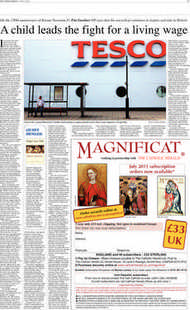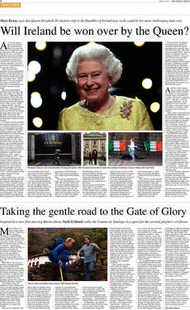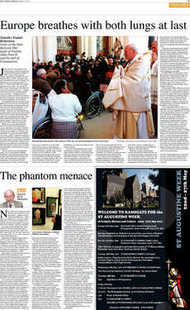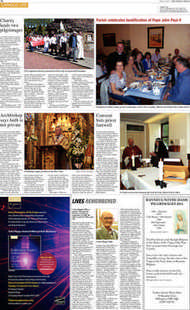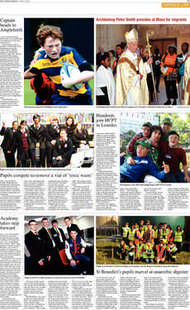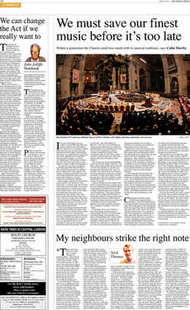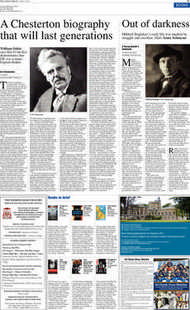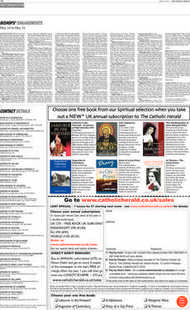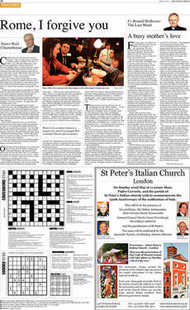Page 8, 13th May 2011
Page 8

Report an error
Noticed an error on this page?If you've noticed an error in this article please click here to report it.
Tags
Share
Related articles
Star Makes Film About The Way Of St James
‘i’ve Stopped Using The Word Coincidence’
Spanish Pilgrims' Way To Santiago
Escape From The Temple Of Tears
Bishop Sheen Leaves Tv
Taking the gentle road to the Gate of Glory
Inspired by a new film starring Martin Sheen Nicki Grihault walks the Camino de Santiago in a quest for the coveted pilgrim’s certificate artin Sheen isn’t new to pilgrimage. He has visited Lourdes, filmed at Medjugorje, clasped Mother Teresa’s hand and sat with Pope John Paul II at the Vatican. As a young boy in Ohio he remembers his Spanish relatives talk of el Camino – and had long dreamed of walking the Way of St James to Santiago de Compostela’s baroque cathedral, where the Apostle’s remains are believed to be buried. It’s the subject of his next film, The Way, released on May 13.
Sheen stars as Tom Avery, a taciturn Californian opthalmologist, whose estranged son, Daniel, is killed in a storm in the Pyrenees on the first day walking the Camino de Santiago. Travelling to France to collect his son’s remains, Tom impulsively stuffs the box of ashes in his son’s backpack and sets off to walk the 500-mile pilgrimage “together”.
The Camino is used as a metaphor for life’s journey, and Tom is not alone for long. Tough Canadian Sarah (Deborah Kara Unger), who wants to quit smoking, gentle giant Dutchman Joost (Yorick van Wageningen), trying to lose weight, and James Nesbitt playing Jack, a lapsed Irish Catholic with writer’s block, provide community as Tom struggles to re-connect with himself.
There are few celebrities with Martin Sheen’s Catholic credentials and fewer still making international films an instrument of faith. As a pacifist and social activist he has been arrested over 60 times. In 2008 his humanitarian work earned him the prestigious Laetare Medal from the University of Notre Dame, the oldest and prestigious award given to an American Catholic.
But it wasn’t faith alone that inspired 70-year-old Ramon Antonio Gerado Estevez (stage name Martin Sheen) to feature the Camino. The last leg of the well-trodden French Way, which travels across northern Spain, passes through Galicia, the homeland of his father. Described as a “love letter to Spain”, this personal, documentary-style film is also a family tribute. Sheen hopes it will draw more visitors to this lesser-known region, whose lush green scenery and clear streams have likened it to Devon or Derbyshire.
Shot along the Camino itself, the film shows highlights such as Leon, Burgos – with its fabulous cathedral built in the 13th century – and Pamplona. The pilgrims encounter a priest who gives Tom a rosary, bear witness to penitents, spend the evening with Romani people and with the police, before arriving in Santiago. Tom then treks to Finistère (“the end of the world”) to say his final goodbye to Daniel. It was at this spot on the Atlantic Ocean, where St James drifted ashore in a boat, his body covered with scallop shells, still the symbol of a pilgrim today. Inspired by the film, with a scallop shell dangling from our day packs, my husband, Nick, and I set off from Sarria in Galicia, 70 miles from Santiago. Although only five days – an eighth of the “really long walk” shown in the film – it’s just enough to earn a pilgrim’s certificate.
Following the sun-yellow arrows and way markers engraved with a scallop shell we walked, like Sheen and company, along winding country lanes through sun-dappled corridors of oak. In rural Galicia cats, cows, dogs and wildflowers are more prolific than people, but after nine miles we joined a group of Spanish pilgrims at a communal restaurant table, for a Galician soup and a stamp in our “pilgrims’ passport”.
A pilgrimage traditionally involves personal sacrifice or suffering and Sheen, like most pilgrims, carries a heavy backpack and stays in albergues (refuges). Although we learn in the film “a true pilgrim walks with nothing”, we felt on a pilgrimage-for-softies with our luggage delivered to the next twoor three-star hotel and a hot meal waiting. An old lady sunning herself on a street corner beamed and wished us “Buen Camino!” anyway – just as the locals do in The Way. And on the third day, 18 miles felt hard without a heavy backpack. Being free allowed to explore and linger, as the Camino wound through pine and eucalyptus-scented woods punctuated with pretty farm hamlets such as Leboreiro, with flagstone paths and Unescorecognised Romanesque church and Furelos, with its impressive medieval bridge.
As we entered Boente’s church a priest enthusiastically blessed us in English before busily packing hosts into a little metal box to tend the sick. A converted pilgrim’s hospital on the riverbank in the hamlet of Ribadiso and pilgrim cemetery nearby was a reminder of ancient times.
Ritualistic spots of spiritual significance are found all along the Camino. At Lavacolla we crossed stream at where pilgrims purified themselves before reaching Santiago and where the Camino encircled Santiago’s airport, a kilometre-long fence of makeshift crosses – a modern and moving expression of faith. In The Way the pilgrims add a stone to the mountain of pebbles below the Cruz de Fero, the Cross of the Saviour, 93 miles before Santiago. We stood like they did, on Monte de Gozo (Mount of Joy), for our first glimpse of the spires of Santiago’s impressive baroque cathedral. Although the pilgrims in The Way pay homage at the statue of St James, at the stunning Gate of Glory at Santiago’s Cathedral, it was under restoration when we got there. They also witness Santiago’s famous ritual of the swinging of a massive incense burner down the central aisle of the cathedral, but that had happened yesterday. Tears flow down Jack’s face as he enters. It’s easy to see why he was moved by its splendour at the pilgrims’ daily Mass at noon where children mingle with bearded men with staffs and backpackers in North Face jackets in front of a glorious gold altar. Feeling like a pilgrim of old, I queued to hug the bejewelled St James behind it. Clutching my newly signed pilgrim’s certificate, I whispered my secrets in his ear, happy to have followed The Way.
Follow The Camino (020 8816 7328, Followthecamino.com) are specialists in walking, cycling and horseback holidays along the various routes and offer a seven night/eight day walking holiday along the last 70 miles of the French Way from Sarria to Santiago de Compostela from €550/£475 per person sharing. Includes half-board accommodation, luggage transfer between hotels, walking notes, scallop shell and pilgrim passport
Film review: Page 14
blog comments powered by Disqus








